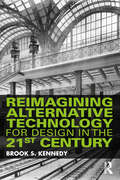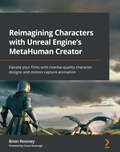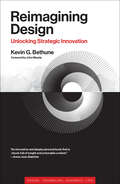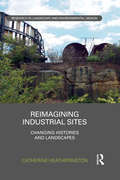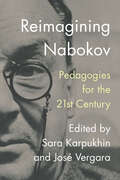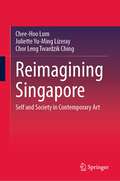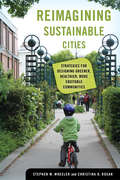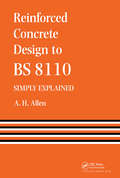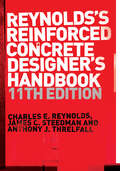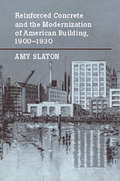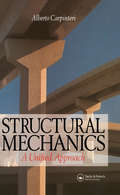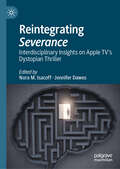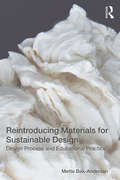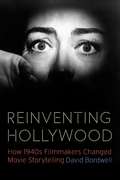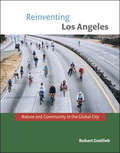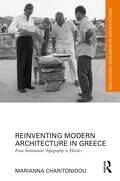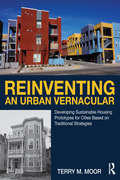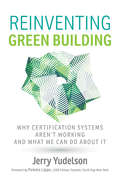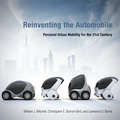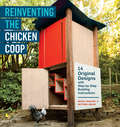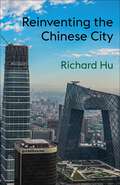- Table View
- List View
Reimag(in)ing the Victorians in Contemporary Art: Britain and Beyond
by Isobel ElstobFrom contemporary deployments of taxidermy, magic lanterns and microscopy to the visualization of forgotten lives, marginalized narratives and colonial histories, this book explores how the work of artists including Mat Collishaw, Yinka Shonibare, Tessa Farmer, Mark Dion, Dorothy Cross and Ingrid Pollard reimag(in)es the Victorians in the ‘present’. Examining how recent paintings, sculptures, photographs, installations and films revisit and re-present nineteenth-century technologies, practices and events, the book’s rich interdisciplinary approach applies literary, media and linguistic theories to its analysis of visual art, alongside in-depth discussions of the Victorian inventions, concepts and narratives that they invoke. The book’s emphasis on how – and why – we represent the historical past makes its contribution particularly timely. And by drawing attention to the importance of historiography to the work of these artists, it also unravels the complicated history of History itself. This book will speak to diverse audiences including those interested in art history, visual culture, Victorian and neo-Victorian studies, as well as literature, histories of science and media, postcolonialism, museology, gender studies, postmodernism and the history of ideas.
Reimagining Alternative Technology for Design in the 21st Century
by Brook S. KennedyReimagining Alternative Technology for Design in the 21st Century presents a new approach to design that harnesses still-valuable alternative, traditional and abandoned technologies alongside the creation of new ones to address contemporary global problems. It focuses on design opportunities that reduce energy and material consumption to tackle issues such as climate change and pollution in industrialized economies. The book takes the reader on a journey surveying different facets of human activity to identify underused and discarded technologies that could be indispensable today. It critically addresses newer approaches to design and technology by comparing them to existing alternatives, unpacking examples including air conditioning with smart thermostats, electric lighting, durable reusable products, domestic maintenance tools and methods of transportation. Written for practicing designers and students in industrial design, architecture, sustainable design and human-centered design, this book provides new ideas and tools for creating more useful, energy-and-resource-efficient product designs and systems.
Reimagining Characters with Unreal Engine's MetaHuman Creator: Elevate your films with cinema-quality character designs and motion capture animation
by Brian Rossney Ciaran KavanaghDiscover the power of Unreal Engine 5 and the MetaHuman Creator to develop realistic digital characters, infusing them with full body and facial animationKey FeaturesCreate realistic characters using the MetaHuman Creator using a mixture of preset and custom toolsImport your character into Unreal Engine 5 to access more editing options and begin animating itCombine face and body motion capturing to fully animate your digital humansBook DescriptionMetaHuman Creator (MHC) is an online, user-friendly 3D design tool for creating highly realistic digital humans that can be animated within Unreal Engine (UE) and enhanced with motion capture technology. This means that filmmakers and game developers now have access to a high quality, affordable solution that was previously only available to specialist studios. This book will focus on using UE5 and MHC from a filmmaker angle. Firstly, you'll understand how to use the online MHC to create a digital character, changing its facial structure, body type, and clothing. After that, you'll learn all the necessary steps to bring the character into UE5 and set it up for animation. Then, using an iPhone and a webcam to capture face and body movements, you'll mix these motion capture files, refine the animations using the MetaHuman Control Rig, and save these takes to be reused and edited again within the Level Sequencer. On top of that, you'll learn how to create a rendered video file for film production using both the Level Sequencer and a VR Cinematic Camera. By the end of this book, you'll have created your own MetaHuman character, as well as face and body motion capture data, and learned the necessary skills to give your future projects further realism and creative control.What you will learnCreate your own bespoke character using MHCDevelop custom faces based on real peopleUtilize Blueprints to take control of your digital characterRetarget animations using the Unreal MannequinUse DeepMotion and Live Link for complete body and face animationUse the Control Rig to refine animationsExport and render your characterWho this book is forThis book is for filmmakers and hobbyists who are planning to make a film using Unreal Engine for the first time, having worked in live action or purely digital media previously, either professionally or as a hobby. No experience with Unreal Engine is required, however it is useful to have some knowledge of 3D development applications and concepts like wireframes, skin weights, transform tools, and motion capture. It is recommended that you have access to an iPhone X (or a later model). Alternatively, you can use a free or paid version of Faceware, along with a basic webcam.
Reimagining Design: Unlocking Strategic Innovation (Simplicity: Design, Technology, Business, Life)
by Kevin G. BethuneThe power of transformative design, multidisciplinary leaps, and diversity: lessons from a Black professional&’s journey through corporate America.Design offers so much more than an aesthetically pleasing logo or banner, a beautification add-on after the heavy lifting. In Reimagining Design, Kevin Bethune shows how design provides a unique angle on problem-solving—how it can be leveraged strategically to cultivate innovation and anchor multidisciplinary teamwork. As he does so, he describes his journey as a Black professional through corporate America, revealing the power of transformative design, multidisciplinary leaps, and diversity. Bethune, who began as an engineer at Westinghouse, moved on to Nike (where he designed Air Jordans), and now works as a sought-after consultant on design and innovation, shows how design can transform both individual lives and organizations. In Bethune&’s account, diversity, equity, and inclusion emerge as a recurring theme. He shows how, as we leverage design for innovation, we also need to consider the broader ecological implications of our decisions and acknowledge the threads of systemic injustice in order to realize positive change. His book is for anyone who has felt like the &“other&”—and also for allies who want to encourage anti-racist, anti-sexist, and anti-ageist behaviors in the workplace. Design transformation takes leadership—leaders who do not act as gatekeepers but, with agility and nimbleness, build teams that mirror the marketplace. Design in harmony with other disciplines can be incredibly powerful; multidisciplinary team collaboration is the foundation of future innovation. With insight and compassion, Bethune provides a framework for bringing this about.
Reimagining Industrial Sites: Changing Histories and Landscapes (Routledge Research in Landscape and Environmental Design)
by Catherine HeatheringtonThe discourse around derelict, former industrial and military sites has grown in recent years. This interest is not only theoretical, and landscape professionals are taking new approaches to the design and development of these sites. This book examines the varied ways in which the histories and qualities of these derelict sites are reimagined in the transformed landscape and considers how such approaches can reveal the dramatic changes that have been wrought on these places over a relatively short time scale. It discusses these issues with reference to eleven sites from the UK, Germany, the USA, Australia and China, focusing specifically on how designers incorporate evidence of landscape change, both cultural and natural. There has been little research into how these developed landscapes are perceived by visitors and local residents. This book examines how the tangible material traces of pastness are interpreted by the visitor and the impact of the intangible elements - hidden traces, experiences and memories. The book draws together theory in the field and implications for practice in landscape architecture and concludes with an examination of how different approaches to revealing and reimagining change can affect the future management of the site.
Reimagining Nabokov: Pedagogies for the 21st Century
by José Vergara Sara KarpukhinIn Reimagining Nabokov: Pedagogies for the 21st Century, eleven teachers of Vladimir Nabokov describe how and why they teach this notoriously difficult, even problematic, writer to the next generations of students. Contributors offer fresh perspectives and embrace emergent pedagogical methods, detailing how developments in technology, translation and archival studies, and new interpretative models have helped them to address urgent questions of power, authority, and identity. Practical and insightful, this volume features exciting methods through which to reimagine the literature classroom as one of shared agency between students, instructors, and the authors they read together. “It is both timely and refreshing to have an influx of teacher-scholars who engage Nabokov from a variety of perspectives… this volume does justice to the breadth of Nabokov’s literary achievements, and it does so with both pedagogical creativity and scholarly integrity” • Dana Dragunoiu, Carleton University "[A] valuable study for any reader, teacher, scholar, or student of Nabokov. Amongst specific and urgent insights on the potential for digital methods, the relevance of Nabokov for students today, and how to reconcile issues of identity with an author who disavowed history and politics, are much wider and timeless questions of authorial control and the ability to access reality."—Anoushka Alexander-Rose, Nabokov Online Journal Contributions by Galya Diment, Tim Harte, Robyn Jensen, Sara Karpukhin, Yuri Leving, Roman Utkin, José Vergara, Meghan Vicks, Olga Voronina, Lisa Ryoko Wakamiya, and Matthew Walker.
Reimagining Singapore: Self and Society in Contemporary Art
by Chee-Hoo Lum Juliette Yu-Ming Lizeray Chor Leng Twardzik ChingThis book approaches the subject of contemporary art by exploring the social embeddedness and identities of Singaporean artists. Linking artistic processes and production to both personal worlds and wider issues, the book examines how artists negotiate their relationships between self and society and between artistic freedom and social responsibility. It is based on original research into the discourses and artistic practices of local artists, with a special focus on emerging artists and artists whose work and perspectives engage with questions of identity. Reimagining contemporary Singapore and their place within it, artists are asserting their multiple and heterogeneous self-identities and contesting hegemonic norms and notions, as they negotiate and adapt to the world around them. This book is relevant to students and researchers in the fields of cultural studies, media studies, art, sociology of art, arts education, and race and ethnicity studies.
Reimagining Sustainable Cities: Strategies for Designing Greener, Healthier, More Equitable Communities
by Stephen M. WheelerA cutting-edge, solutions-oriented analysis of how we can reimagine cities around the world to build sustainable futures. What would it take to make urban places greener, more affordable, more equitable, and healthier for everyone? In recent years, cities have stepped up efforts to address climate and sustainability crises. But progress has not been fast enough or gone deep enough. If communities are to thrive in the future, we need to quickly imagine and implement an entirely new approach to urban development: one that is centered on equity and rethinks social, political, and economic systems as well as urban designs. With attention to this need for structural change, Reimagining Sustainable Cities advocates for a community-informed model of racially, economically, and socially just cities and regions. The book aims to rethink urban sustainability for a new era. In Reimagining Sustainable Cities, Stephen M. Wheeler and Christina D. Rosan ask big-picture questions of interest to readers worldwide: How do we get to carbon neutrality? How do we adapt to a climate-changed world? How can we create affordable, inclusive, and equitable cities? While many books dwell on the analysis of problems, Reimagining Sustainable Cities prioritizes solutions-oriented thinking—surveying historical trends, providing examples of constructive action worldwide, and outlining alternative problem-solving strategies. Wheeler and Rosan use a social ecology lens and draw perspectives from multiple disciplines. Positive, readable, and constructive in tone, Reimagining Sustainable Cities identifies actions ranging from urban design to institutional restructuring that can bring about fundamental change and prepare us for the challenges ahead.
Reina Ramos Works It Out (I Can Read Level 2)
by Emma Otheguy"A sparkling tale starring a resilient young protagonist" —Kirkus (starred review)Reina Ramos Works It Out is a Level Two I Can Read story about Reina Ramos, a loyal friend whose high-spirited antics sometimes cause chaos, but who always finds a way to make things right. Perfect for social emotional learning!Reina Ramos is excited about dressing up as Frida Kahlo for the class wax museum. Frida was a strong person like her mami and abuela—plus Reina has the perfect headband for the costume! But when her best friend Nora picks Frida first, Reina doesn’t know what to do. Who will she dress up as now?Reina Ramos Works It Out is a Level Two I Can Read book, geared for kids who read on their own but still need a little help. Whether shared at home or in a classroom, the engaging stories, longer sentences, and language play of Level Two books are proven to help kids take their next steps toward reading success.The story also contains several Spanish words, a glossary, and a list of famous people mentioned in the book.“This level 2 beginning reader contains an engaging, relatable story for emergent readers that features simple text, a sprinkling of Spanish vocabulary, and sweet illustrations on each page.” —Booklist"The Spanish words and positive messages about managing conflict and problem-solving make this a welcome addition to beginning reader collections." —School Library Journal
Reinforced Concrete Design to BS 8110 Simply Explained
by A. AllenThis highly successful book describes the background to the design principles, methods and procedures required in the design process for reinforced concrete structures. The easy to follow style makes it an ideal reference for students and professionals alike.
Reinforced Concrete Designer's Handbook
by Charles E. Reynolds James C. Steedman Anthony J. ThrelfallThis classic and essential work has been thoroughly revised and updated in line with the requirements of new codes and standards which have been introduced in recent years, including the new Eurocode as well as up-to-date British Standards. <P><P> It provides a general introduction along with details of analysis and design of a wide range of structures and examination of design according to British and then European Codes. <P><P> Highly illustrated with numerous line diagrams, tables and worked examples, Reynolds's Reinforced Concrete Designer's Handbook is a unique resource providing comprehensive guidance that enables the engineer to analyze and design reinforced concrete buildings, bridges, retaining walls, and containment structures. <P><P> Written for structural engineers, contractors, consulting engineers, local and health authorities, and utilities, this is also excellent for civil and architecture departments in universities and FE colleges.
Reinforced Concrete and the Modernization of American Building, 1900-1930 (Johns Hopkins Studies in the History of Technology)
by Amy E. SlatonExamining the proliferation of reinforced-concrete construction in the United States after 1900, historian Amy E. Slaton considers how scientific approaches and occupations displaced traditionally skilled labor. The technology of concrete buildings—little studied by historians of engineering, architecture, or industry—offers a remarkable case study in the modernization of American production.The use of concrete brought to construction the new procedures and priorities of mass production. These included a comprehensive application of science to commercial enterprise and vast redistributions of skills, opportunities, credit, and risk in the workplace. Reinforced concrete also changed the American landscape as building buyers embraced the architectural uniformity and simplicity to which the technology was best suited. Based on a wealth of data that includes university curricula, laboratory and company records, organizational proceedings, blueprints, and promotional materials as well as a rich body of physical evidence such as tools, instruments, building materials, and surviving reinforced-concrete buildings, this book tests the thesis that modern mass production in the United States came about not simply in answer to manufacturers' search for profits, but as a result of a complex of occupational and cultural agendas.
Reinforced and Prestressed Concrete: Incorporation Bs 8110 And Microcomputer Applications
by F. K. Kong R. H. EvansThis highly successful textbook has been comprehensively revised for two main reasons: to bring the book up-to-date and make it compatible with BS8110 1985; and to take into account the increasing use made of microcomputers in civil engineering. An important new chapter on microcomputer applications has been added.
Reintegrating Severance: Interdisciplinary Insights on Apple TV’s Dystopian Thriller
by Jennifer Dawes Nora M. IsacoffThis edited collection is an interdisciplinary examination of Apple TV's Severance, in which employees of a biotech firm consent to having their brains severed so that their work selves and non-work selves do not retain each other’s memories. What transpires is a reckoning with the very nature of the self, consciousness, and memory, through a series steeped in explorations of capitalism, social welfare, and bioethics. Chapters in this book examine the popularity and critical acclaim surrounding the show; its retrofuturistic asethetic; its commentary on popular culture and identity; and its engagement with nostalgia, among other topics.
Reintroducing Materials for Sustainable Design: Design Process and Educational Practice
by Mette Bak-AndersenReintroducing Materials for Sustainable Design provides instrumental theory and practical guidance to bring materials back into a central role in the design process and education. To create designs that are sustainable and respond to current environmental, economic and cultural concerns, practitioners and educators require a clear framework for materials use in design and product manufacturing. While much has been written about sustainable design over the last two decades, outlining systems of sustainability and product criteria, to design for material circularity requires a detailed understanding of the physical matter that constitutes products. Designers must not just know of materials but know how to manipulate them and work with them creatively. This book responds to the gap by offering a way to acquire the material knowledge necessary to design physical objects for sustainability. It reinforces the key role and responsibility of designers and encourages designers to take back control over the ideation and manufacturing process. Finally, it discusses the educational practice involved and the potential implications for design education following implementation, addressing didactics, facilities and expertise. This guide is a must-read for designers, educators and researchers engaged in sustainable product design and materials.
Reinventing Brantford: A University Comes Downtown
by Leo GroarkeShort-listed for the 2012 Speaker’s Award One hundred years ago, the City of Brantford advertised itself as the most important manufacturing centre in Canada. During the century that followed, its industrial economy boomed, faltered, and finally collapsed. By the end of the twentieth century, Brantford was known for unemployment, hard luck, and the infamy of having "the worst downtown in Canada." For twenty years the downtown was in steep decline. Significant attempts at urban revival had failed until Wilfrid Laurier University decided to locate a campus in the heart of Brantford’s crumbling city centre. Leo Groarke revisists the grandeur of the city’s past, explores the economic downfall, and tells the story of the arrival of the university, its early struggles, its commitment to historic restoration, and its ultimate success as a catalyst for urban renewal. The compelling story he recounts will engage anyone interested in the plight of the North-American city core and the role that universities and colleges can play in re-establishing downtowns as vibrant centres of historical and contemporary importance.
Reinventing Civil Society: The Emerging Role of Faith-Based Organizations
by Richard C. Hula Laura A. Reese Cynthia Jackson-ElmooreThis guide concentrates on resources that are useful, in an easy-to-use format to enable architects, designers and engineers to access a wealth of knowledge. Information allows users to find, evaluate and contact the resources that can save time and money in day-to-day practice.
Reinventing Hollywood: How 1940s Filmmakers Changed Movie Storytelling
by David BordwellIn the 1940s, American movies changed. Flashbacks began to be used in outrageous, unpredictable ways. Soundtracks flaunted voice-over commentary, and characters might pivot from a scene to address the viewer. Incidents were replayed from different characters’ viewpoints, and sometimes those versions proved to be false. Films now plunged viewers into characters’ memories, dreams, and hallucinations. Some films didn’t have protagonists, while others centered on anti-heroes or psychopaths. Women might be on the verge of madness, and neurotic heroes lurched into violent confrontations. Combining many of these ingredients, a new genre emerged—the psychological thriller, populated by women in peril and innocent bystanders targeted for death. If this sounds like today’s cinema, that’s because it is. In Reinventing Hollywood, David Bordwell examines the full range and depth of trends that crystallized into traditions. He shows how the Christopher Nolans and Quentin Tarantinos of today owe an immense debt to the dynamic, occasionally delirious narrative experiments of the Forties. Through in-depth analyses of films both famous and virtually unknown, from Our Town and All About Eve to Swell Guy and The Guilt of Janet Ames, Bordwell assesses the era’s unique achievements and its legacy for future filmmakers. Reinventing Hollywood is a groundbreaking study of how Hollywood storytelling became a more complex art and essential reading for lovers of popular cinema.
Reinventing Los Angeles: Nature and Community in the Global City (Urban and Industrial Environments)
by Robert GottliebDescribes how water politics, cars and freeways, and immigration and globalization have shaped Los Angeles, and how innovative social movements are working to make a more livable and sustainable city.Los Angeles—the place without a sense of place, famous for sprawl and overdevelopment and defined by its car-clogged freeways—might seem inhospitable to ideas about connecting with nature and community. But in Reinventing Los Angeles, educator and activist Robert Gottlieb describes how imaginative and innovative social movements have coalesced around the issues of water development, cars and freeways, and land use, to create a more livable and sustainable city. Gottlieb traces the emergence of Los Angeles as a global city in the twentieth century and describes its continuing evolution today. He examines the powerful influences of immigration and economic globalization as they intersect with changes in the politics of water, transportation, and land use, and illustrates each of these core concerns with an account of grass roots and activist responses: efforts to reenvision the concrete-bound, fenced-off Los Angeles River as a natural resource; “Arroyofest,” the closing of the Pasadena Freeway for a Sunday of walking and bike riding; and immigrants' initiatives to create urban gardens and connect with their countries of origin. Reinventing Los Angeles is a unique blend of personal narrative (Gottlieb himself participated in several of the grass roots actions described in the book) and historical and theoretical discussion. It provides a road map for a new environmentalism of everyday life, demonstrating the opportunities for renewal in a global city.
Reinventing Modern Architecture in Greece: From Sentimental Topography to Ekistics (Routledge Research in Architecture)
by Marianna CharitonidouThis book examines the connection between the politics of the Marshall Plan and urban planning and identifies the key players, such as the Greek architect and urban planner Constantinos A. Doxiadis and the Italian industrialist Adriano Olivetti. It also explores the architects of the Mataroa mission, who played a vital role in the cross-fertilisation between France and Greece, and the role of travel to Greece for architects during the 19th century.This book delves into the work of Constantinos A. Doxiadis, Adriano Olivetti, Alison and Peter Smithson, Iannis Xenakis, Takis Zenetos, Henri Lefebvre, Cornelius Castoriadis, Aris Konstantinidis, Dimitris Pikionis and others. It sheds light on how Doxiadis introduced “ekistics” as a novel approach to understanding the science of human settlements. This book proposes that the manner in which these aforementioned architects and urban planners addressed the role of technology in everyday life and the relationship between society, history, culture, nature, architecture and urban planning could enrich our ongoing methods and debates on architecture, urban planning, ecology, social equity and democracy.This book is based on extensive archival research and will be of interest to architects, artists, researchers and students and scholars in architecture, architectural history and theory, art, urban sociology, cultural theory, science and technology studies, philosophy, ecology, cybernetics and aesthetics.
Reinventing an Urban Vernacular: Developing Sustainable Housing Prototypes for Cities Based on Traditional Strategies
by Terry MoorWith increasing population and its associated demand on our limited resources, we need to rethink our current strategies for construction of multifamily buildings in urban areas. Reinventing an Urban Vernacular addresses these new demands for smaller and more efficient housing units adapted to local climate. In order to find solutions and to promote better urban communities with an overall environmentally responsible lifestyle, this book examines a wide variety of vernacular building precedents, as they relate to the unique characteristics and demands of six distinctly different regions of the United States. Terry Moor addresses the unique landscape, climate, physical, and social development by analyzing vernacular precedents, and proposing new suggestions for modern needs and expectations. Written for students and architects, planners, and urban designers, Reinventing an Urban Vernacular marries the urban vernacular with ongoing sustainability efforts to produce a unique solution to the housing needs of the changing urban environment.
Reinventing green building
by Jerry YudelsonBuildings and their associated systems are the largest source of greenhouse gases in the world. The 2030 Challenge aims to produce zero net -energy from new North American construction by 2030 while achieving a 50% reduction in carbon emissions from existing buildings. With less than 4% of commercial and residential structures in the U. S. and Canada certified by 2015, we seem destined to fall catastrophically short of this target. Reinventing Green Building combines a unique, insider's critique of the current state of affairs with a potent vision for the future. This highly visual, data-driven analysis brings together the wisdom of today's leading practitioners including: Up-to-date information on green building issues, energy economics and new technology Dramatic new approaches to certification system design and user experience Creative, outside-the-box solutions using the Internet of Things, big data analytics and cloud-based technologies for building management. The green building revolution has failed to fulfill its promise to transform the marketplace in a meaningful way. Smart, simple, and sustainable: Reinventing Green Building presents a new approach to building certification, designed to radically cut costs while dramatically increasing marketplace acceptance integrating true climate mitigation and better building performance.
Reinventing the Automobile: Personal Urban Mobility for the 21st Century (The\mit Press Ser.)
by William J. Mitchell Chris E. Borroni-Bird Lawrence D. BurnsHow to leave behind our unwieldy, gas-guzzling, carbon dioxide–emitting vehicles for cars that are green, smart, connected, and fun. This book provides a long-overdue vision for a new automobile era. The cars we drive today follow the same underlying design principles as the Model Ts of a hundred years ago and the tail-finned sedans of fifty years ago. In the twenty-first century, cars are still made for twentieth-century purposes. They are inefficient for providing personal mobility within cities—where most of the world's people now live. In this pathbreaking book, William Mitchell and two industry experts reimagine the automobile, describing vehicles of the near future that are green, smart, connected, and fun to drive. They roll out four big ideas that will make this both feasible and timely.The fundamental reinvention of the automobile won't be easy, but it is an urgent necessity—to make urban mobility more convenient and sustainable, to make cities more livable, and to help bring the automobile industry out of crisis.
Reinventing the Chicken Coop: 14 Original Designs with Step-by-Step Building Instructions
by Kevin McElroy Matthew WolpeBuild a stylishly modern home for your poultry. Backyard chickens meet contemporary design in this inventive compilation from authors Matthew Wolpe and Kevin McElroy. Reinventing the Chicken Coop presents 14 complete building plans for chicken houses that range from the purely functional to outrageously fabulous, with designs that include water-capturing roofs, built-in composting systems, and modernist architectural details.
Reinventing the Chinese City
by Richard HuSince the late 1970s, China has undergone perhaps the most sweeping process of urbanization ever witnessed. This is typically understood as a story of growth, encompassing rapid development and economic dynamism alongside environmental degradation and social dislocation. However, over the past decade, China’s leaders have claimed that the country’s urbanization has entered a new stage that prioritizes “quality.” What does China’s new urban vision entail, and what does the future hold in store?Richard Hu unpacks recent trends in urban planning and development to explore the making and imagining of the contemporary Chinese city. He focuses on three key concepts—the “green revolution,” “smart city movement,” and “great innovation leap forward”—that have become increasingly influential. Through case studies of Beijing, Hangzhou, and Hefei, Hu analyzes how attempts to achieve greater sustainability, promote data-driven governance, and foster innovation have fared on the ground. He also considers the experimental city Xiong’an in terms of China’s idealized vision of the urban future and investigates how the recent experiences of Hong Kong relate to regional and national development projects.Reinventing the Chinese City provides a careful accounting of the ideas that have dominated urban policy in China since 2010, emphasizing key continuities underlying claims of novelty. Shedding light on the transformations of the Chinese city, this book offers a new perspective on the factors that will shape the trajectory of urbanization in the coming decades.

